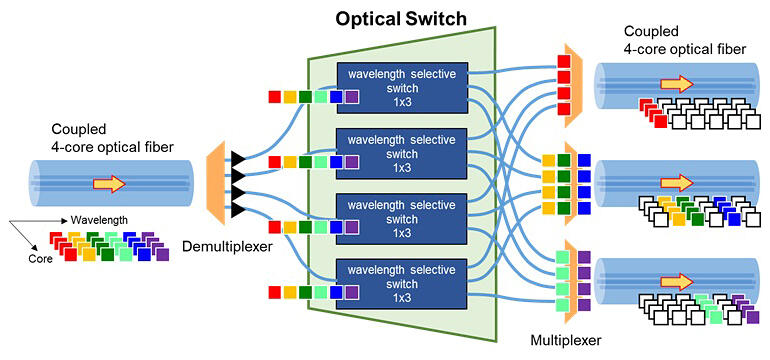On May 11, a group led by Senior Researcher Ruben Soares Luís of the Network Research Institute at the National Institute of Information and Communications Technology (NICT) established a standard outer diameter coupled 4-core optical fiber on a real-world testbed in L'Aquila, Italy. An optical network equipped with an optical switching function was constructed using a fiber and prototype optical switch that supported it, and the world's first successful optical switching experiment of a coupled multicore optical fiber in a real environment was conducted. The experiment was conducted in collaboration with the University of L'Aquila, Italy; Heinrich Hertz Institute, Germany; Finisar, Australia; and Sumitomo Electric Industries, Japan.
The coupled multicore optical fiber is expected to be a new transmission medium that excels in long-distance, high-capacity transmission. This success will significantly advance the technology for constructing long-haul, high-capacity optical networks after Beyond 5G.

Provided by the National Institute of Information and Communications Technology (NICT)
To cope with ever-increasing communication traffic, spatial division multiplexing (SDM) transmission technology using new optical fibers is being studied. In addition to transmission technology, optical switching technology compatible with SDM is essential for the construction of optical networks. NICT has developed optical switches compatible with uncoupled multicore and multimode optical fibers and has demonstrated SDM optical networks with optical switching functions.
For longer distances and higher capacities, optical networks composed of coupled multicore optical fibers, which require more advanced technology than non-coupled networks, are expected. There are only reports of optical switching experiments in laboratories; there have been no demonstrations of optical switching in optical networks in real environments.
In this research, an optical switch compatible with a standard outer diameter coupled 4-core optical fiber was independently configured with a commercially available wavelength selective switch, and a coupled multicore optical fiber network constructed on a real-world testbed was able to measure wavelengths. This was the first successful optical switching experiment in the world.
The constructed optical network consisted of optical transmitters/receivers and optical switches for spatial and wavelength-division multiplexing signals installed at the University of L'Aquila and a coupled 4-core optical fiber (62.9 km) laid in the city of L'Aquila to simulate a mesh-like optical network.
In the experiment, multiplexed signals of 12 terabits per second (six wavelength multiplexing, four spatial multiplexing, 500 gigabits per wavelength channel) were generated and transmitted over a coupled 4-core optical fiber. Then, the path was switched for each wavelength using an optical switch.
The optical switch for the coupled 4-core optical fiber consisted of four 1-input 3-output (1 × 3) wavelength selective switches, assuming switching to a 3-way path.
A network node was constructed with four of these optical switches, and 19 different switching patterns were evaluated, including the insertion and branching of all wavelengths, passage of all wavelengths, and insertion and branching of some wavelengths. As a result, the group confirmed that all of them could be correctly received after switching and demonstrated all the basic switching functions required for network nodes.
While uncoupled multicore optical fibers require appropriately spaced cores to suppress signal interference between cores, coupled multicore optical fibers have the advantage that this effect can be eliminated via Multiple-Input Multiple-Output (MIMO) digital signal processing, increasing the number of cores (multiplexing) of standard OD optical fibers.
In addition, the coupling-type multicore optical fiber is expected to be a next-generation optical fiber for long-distance transmission because it can reduce the signal processing load (power consumption) during long-distance transmission compared with the multimode optical fiber.
In addition, inexpensive system installation can be expected because the system can be configured with standard outer diameter optical fibers, which are relatively easy to manufacture. Thus, optical switches compatible with coupled multicore optical fibers are a promising technology for the construction of future long-haul, high-capacity optical networks.
NICT intends to increase the capacity of SDM communications based on standard outer diameter coupled multicore optical fibers by increasing the number of coupled cores and the wavelength multiplexing bandwidth and increasing the number of optical switches to support this, thereby establishing the basic technology for future long-distance, high-capacity optical networks.
Journal Information
Publication: Optical Fiber Communication Conference 2023
Title: Colorless and Directionless ROADM for Meshed Coupled-Core Multicore Fiber Networks
DOI: 10.1364/OFC.2023.Th4C.3
This article has been translated by JST with permission from The Science News Ltd. (https://sci-news.co.jp/). Unauthorized reproduction of the article and photographs is prohibited.




